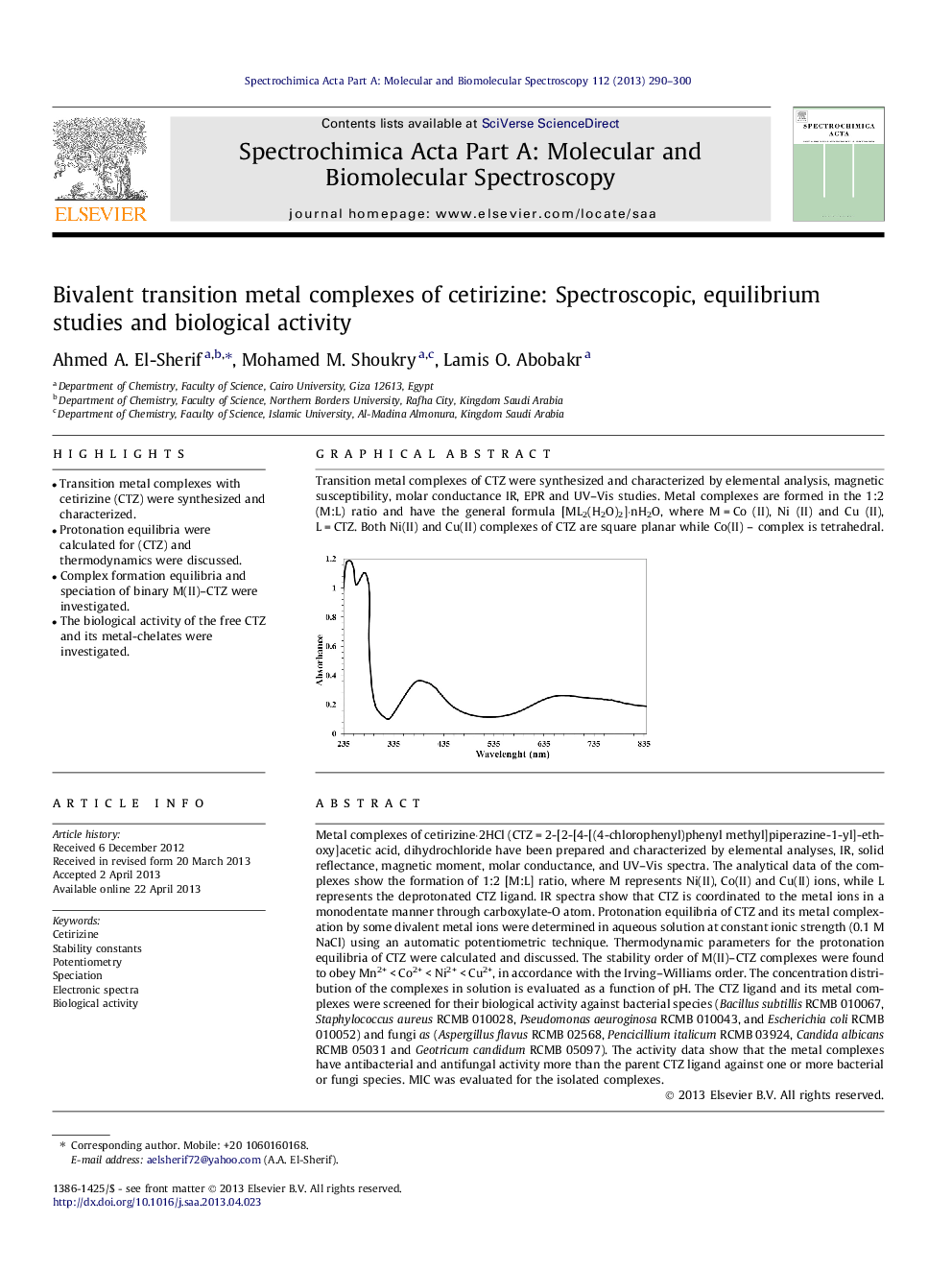| Article ID | Journal | Published Year | Pages | File Type |
|---|---|---|---|---|
| 1230748 | Spectrochimica Acta Part A: Molecular and Biomolecular Spectroscopy | 2013 | 11 Pages |
•Transition metal complexes with cetirizine (CTZ) were synthesized and characterized.•Protonation equilibria were calculated for (CTZ) and thermodynamics were discussed.•Complex formation equilibria and speciation of binary M(II)–CTZ were investigated.•The biological activity of the free CTZ and its metal-chelates were investigated.
Metal complexes of cetirizine⋅2HCl (CTZ = 2-[2-[4-[(4-chlorophenyl)phenyl methyl]piperazine-1-yl]-ethoxy]acetic acid, dihydrochloride have been prepared and characterized by elemental analyses, IR, solid reflectance, magnetic moment, molar conductance, and UV–Vis spectra. The analytical data of the complexes show the formation of 1:2 [M:L] ratio, where M represents Ni(II), Co(II) and Cu(II) ions, while L represents the deprotonated CTZ ligand. IR spectra show that CTZ is coordinated to the metal ions in a monodentate manner through carboxylate-O atom. Protonation equilibria of CTZ and its metal complexation by some divalent metal ions were determined in aqueous solution at constant ionic strength (0.1 M NaCl) using an automatic potentiometric technique. Thermodynamic parameters for the protonation equilibria of CTZ were calculated and discussed. The stability order of M(II)–CTZ complexes were found to obey Mn2+ < Co2+ < Ni2+ < Cu2+, in accordance with the Irving–Williams order. The concentration distribution of the complexes in solution is evaluated as a function of pH. The CTZ ligand and its metal complexes were screened for their biological activity against bacterial species (Bacillus subtillis RCMB 010067, Staphylococcus aureus RCMB 010028, Pseudomonas aeuroginosa RCMB 010043, and Escherichia coli RCMB 010052) and fungi as (Aspergillus flavus RCMB 02568, Pencicillium italicum RCMB 03924, Candida albicans RCMB 05031 and Geotricum candidum RCMB 05097). The activity data show that the metal complexes have antibacterial and antifungal activity more than the parent CTZ ligand against one or more bacterial or fungi species. MIC was evaluated for the isolated complexes.
Graphical abstractTransition metal complexes of CTZ were synthesized and characterized by elemental analysis, magnetic susceptibility, molar conductance IR, EPR and UV–Vis studies. Metal complexes are formed in the 1:2 (M:L) ratio and have the general formula [ML2(H2O)2]⋅nH2O, where M = Co (II), Ni (II) and Cu (II), L = CTZ. Both Ni(II) and Cu(II) complexes of CTZ are square planar while Co(II) – complex is tetrahedral.Figure optionsDownload full-size imageDownload as PowerPoint slide
